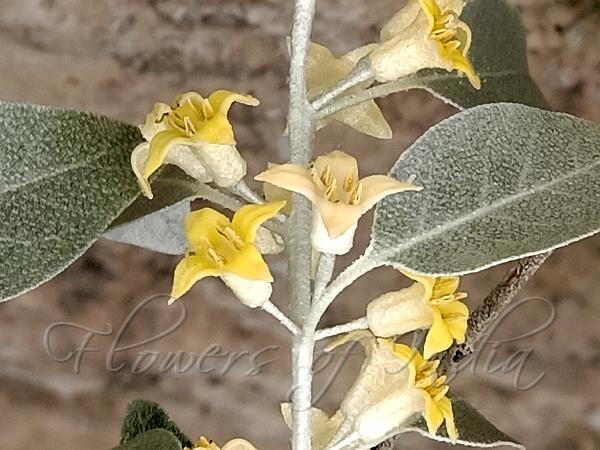|
| Russian Silverberry |
|

|

| File size | 462561 |
| Original date | 6/15/21 5:23 PM |
| Resolution | 4000 x 1808 |
| Flash | Flash did not fire, auto |
| Focal length | 6.25mm |
| Exposure time | 1/100s |
| Aperture | 2.4 |
| Focus Distance | |
| Metering Mode | Center weighted average |
| Camera make | OPPO |
| Camera model | OPPO Reno3 Pro 4G |
| Sensor type |
|
|
|
|
Photo: |
Botanical name: Elaeagnus angustifolia Family: Elaeagnaceae (Silverberry family)
Synonyms: Elaeagnus orientalis, Elaeagnus hortensis, Elaeagnus igda
Synonyms: Elaeagnus orientalis, Elaeagnus hortensis, Elaeagnus igda
Russian Silverberry is a usually thorny shrub or small tree
growing up to 5-7 m in height. Its stems, buds, and leaves have a dense
covering of silvery to rusty scales. The leaves are alternate,
lanceshaped, 4-9 cm long and 1.0-2.5 cm broad, with an entire margin.
The highly aromatic flowers, produced in clusters of one to three, are
1 cm long with a four-lobed creamy yellow sepal-cup. Flower appear in
early summer and are followed by clusters of fruit, a small cherry-like
drupe 1.0-1.7 cm long, orange-red covered in silvery scales. The fruits
are sweet, though with a dryish, mealy texture. Russian Silverberry is found
in Eastern Europe, Russia, Central Asia to China and Western Himalaya.
Medicinal uses: The plant is famous for its
medicinal application. The berry is useful in treating flu, fever,
cough, diarrhea, joint pain, ulcer, gastric problem, kidney problems,
etc. Not just the berry, the leaves of the plant are considered being a
good source of
vitamin and are used as tea leaves. It also acts as a
pain killer. The roots of the plant are used to treat kidney problems.
Oil is produced from the seed and is also used as medicine.
The plant is famous for its
medicinal application. The berry is useful in treating flu, fever,
cough, diarrhea, joint pain, ulcer, gastric problem, kidney problems,
etc. Not just the berry, the leaves of the plant are considered being a
good source of
vitamin and are used as tea leaves. It also acts as a
pain killer. The roots of the plant are used to treat kidney problems.
Oil is produced from the seed and is also used as medicine.
Medicinal uses:
 The plant is famous for its
medicinal application. The berry is useful in treating flu, fever,
cough, diarrhea, joint pain, ulcer, gastric problem, kidney problems,
etc. Not just the berry, the leaves of the plant are considered being a
good source of
vitamin and are used as tea leaves. It also acts as a
pain killer. The roots of the plant are used to treat kidney problems.
Oil is produced from the seed and is also used as medicine.
The plant is famous for its
medicinal application. The berry is useful in treating flu, fever,
cough, diarrhea, joint pain, ulcer, gastric problem, kidney problems,
etc. Not just the berry, the leaves of the plant are considered being a
good source of
vitamin and are used as tea leaves. It also acts as a
pain killer. The roots of the plant are used to treat kidney problems.
Oil is produced from the seed and is also used as medicine. | Identification credit: Sonam Tamchos | Photographed in Ladakh. |
• Is this flower misidentified? If yes,